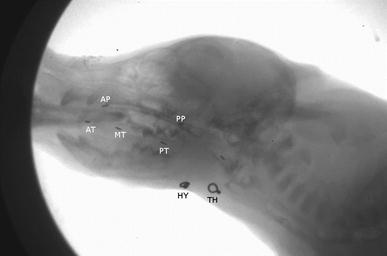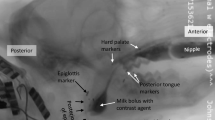Abstract
Recurrent laryngeal nerve (RLN) injury in neonates, a complication of patent ductus arteriosus corrective surgery, leads to aspiration and swallowing complications. Severity of symptoms and prognosis for recovery are variable. We transected the RLN unilaterally in an infant mammalian animal model to characterize the degree and variability of dysphagia in a controlled experimental setting. We tested the hypotheses that (1) both airway protection and esophageal function would be compromised by lesion, (2) given our design, variability between multiple post-lesion trials would be minimal, and (3) variability among individuals would be minimal. Individuals’ swallowing performance was assessed pre- and post-lesion using high speed VFSS. Aspiration was assessed using the Infant Mammalian Penetration-Aspiration Scale (IMPAS). Esophageal function was assessed using two measures devised for this study. Our results indicate that RLN lesion leads to increased frequency of aspiration, and increased esophageal dysfunction, with significant variation in these basic patterns at all levels. On average, aspiration worsened with time post-lesion. Within a single feeding sequence, the distribution of unsafe swallows varied. Individuals changed post-lesion either by increasing average IMPAS score, or by increasing variation in IMPAS score. Unilateral RLN transection resulted in dysphagia with both compromised airway protection and esophageal function. Despite consistent, experimentally controlled injury, significant variation in response to lesion remained. Aspiration following RLN lesion was due to more than unilateral vocal fold paralysis. We suggest that neurological variation underlies this pattern.







Similar content being viewed by others
References
Benjamin JR, Smith PB, Cotten CM, Jaggers J, Goldstein RF, Malcolm WF. Long-term morbidities associated with vocal cord paralysis after surgical closure of a patent ductus arteriosus in extremely low birth weight infants. J Perinatol. 2010;30:408–13.
Pereira Kda R, Firpo C, Gasparin M, Teixeira AR, Dornelles S, Bacaltchuk T, et al. Evaluation of swallowing in infants with congenital heart defect. Int Arch Otorhinolaryngol. 2015;19:055–60.
Pereira KD, Webb BD, Blakely ML, Cox CS Jr, Lally KP. Sequelae of recurrent laryngeal nerve injury after patent ductus arteriosus ligation. Int J Pediatr Otorhinolaryngol. 2006;70:1609–12.
Nichols BG, Jabbour J, Hehir DA, Ghanayem NS, Beste D, Martin T, et al. Recovery of vocal fold immobility following isolated patent ductus arteriosus ligation. Int J Pediatr Otorhinolaryngol. 2014;78:1316–9.
De Gaudemar I, Roudaire M, François M, Narcy P. Outcome of laryngeal paralysis in neonates: a long term retrospective study of 113 cases. Int J Pediatr Otorhinolaryngol. 1996;34:101–10.
Chiang F-Y, Lu I-C, Kuo W-R, Lee K-W, Chang N-C, Wu C-W. The mechanism of recurrent laryngeal nerve injury during thyroid surgery—The application of intraoperative neuromonitoring. Surgery. 2008;143:743–9.
Mattsson P, Hydman J, Svensson M. Recovery of laryngeal function after intraoperative injury to the recurrent laryngeal nerve. Gland Surg. 2015;4:27–35.
German RZ, Crompton AW, Thexton AJ. Integration of the reflex pharyngeal swallow into rhythmic oral activity in a neurologically intact pig model. J Neurophysiol. 2009;102:1017–25.
Thexton AJ, Crompton AW, German RZ. EMG activity in hyoid muscles during pig suckling. J Appl Physiol. 2012;112:1512–9.
Pitts T. Airway protective mechanisms. LUNG. 2014;1–5.
Jafari S, Prince RA, Kim DY, Paydarfar D. Sensory regulation of swallowing and airway protection: a role for the internal superior laryngeal nerve in humans. J Physiol. 2003;550:287–304.
Ding P, Campbell-Malone R, Holman SD, Lukasik SL, Fukuhara T, Gierbolini-Norat EM, et al. Unilateral superior laryngeal nerve lesion in an animal model of dysphagia and its effect on sucking and swallowing. Dysphagia. 2013;28:404–12.
Holman SD, Waranch DR, Campbell-Malone R, Ding P, Gierbolini-Norat EM, Lukasik SL, et al. Sucking and swallowing rates after palatal anesthesia: an electromyographic study in infant pigs. J Neurophysiol. 2013;110:387–96.
Humbert IA, Lokhande A, Christopherson H, German R, Stone A. Adaptation of swallowing hyo-laryngeal kinematics is distinct in oral vs. pharyngeal sensory processing. J Appl Physiol. 2012;112:1698–705.
Rubin AD, Sataloff RT. Vocal fold paresis and paralysis. Otolaryngol Clin North Am. 2007;40:1109–31.
Brok HAJ, Copper MP, Stroeve RJ, de Visser BWO, Venker-van Haagen AJ, Schouwenburg PF. Evidence for recurrent laryngeal nerve contribution in motor innervation of the human cricopharyngeal muscle. Laryngoscope. 1999;109:705–8.
German RZ, Crompton AW, Levitch LC, Thexton AJ. The mechanism of suckling in two species of infant mammal: miniature pigs and long-tailed macaques. J Exp Zool. 1992;261:322–30.
Thexton AJ, Crompton AW. The control of swallowing. In: Linden RWA, editor. Frontiers of Oral Biology (Internet). Basel: KARGER; 1998. p. 168–222.
Thexton AJ, Crompton AW, German RZ. Transition from suckling to drinking at weaning: a kinematic and electromyographic study in miniature pigs. J Exp Zool. 1998;280:327–43.
German RZ, Crompton AW, Owerkowicz T, Thexton AJ. Volume and rate of milk delivery as determinants of swallowing in an infant model animal (Sus scrofia). Dysphagia. 2004;19:147–54.
Ding P, Campbell-Malone R, Holman SD, Lukasik SL, Thexton AJ, German RZ. The effect of unilateral superior laryngeal nerve lesion on swallowing threshold volume. Laryngoscope. 2013;123:1942–7.
German RZ, Crompton AW. The ontogeny of feeding in mammals. In: Schwenk K, editor. Feeding: form, function and evolution in tetrapod vertebrates. San Diego: Academic Press; 2000. p. 537.
Sasaki CT, Hundal JS, Kim Y-H. Protective glottic closure: biomechanical effects of selective laryngeal denervation. Ann Otol Rhinol Laryngol. 2005;114:271–5.
Ross CF, Dharia R, Herring SW, Hylander WL, Liu Z-J, Rafferty KL, et al. Modulation of mandibular loading and bite force in mammals during mastication. J Exp Biol. 2007;210:1046–63.
Liu ZJ, Yamamura B, Shcherbatyy V, Green JR. Regional volumetric change of the tongue during mastication in pigs. J Oral Rehabil. 2008;35:604–12.
Sun Z, Herring SW. The effect of periosteal injury and masticatory micromovement on the healing of a mandibular distraction osteogenesis site. Arch Oral Biol. 2009;54:205–15.
Rasch S, Sangild PT, Gregersen H, Schmidt M, Omari T, Lau C. The preterm piglet—a model in the study of oesophageal development in preterm neonates. Acta Paediatr. 2010;99(2):201–8.
Heaton JT, McMahon TA, Kobler JB, Barry DT, Goldstein EA, Hillman RE. Recurrent laryngeal nerve transposition in guinea pigs. Ann Otol Rhinol Laryngol. 2000;109:972–80.
Holman SD, Campbell-Malone R, Ding P, Gierbolini-Norat EM, Griffioen AM, Inokuchi H, et al. Development, reliability, and validation of an infant mammalian penetration-aspiration scale. Dysphagia. 2012;28:178–87.
German RZ, Crompton AW, Thexton AJ. Variation in EMG activity: a hierarchical approach. Integr Comp Biol. 2008;48:283–93.
Vonesh E, Chinchilli VM. Linear and nonlinear models for the analysis of repeated measurements. London: CRC Press; 1996.
Quinn GP, Keough MJ. Experimental design and data analysis for biologists. Cambridge: Cambridge University Press; 2002.
Rocha AD, Moreira MEL, Pimenta HP, Ramos JRM, Lucena SL. A randomized study of the efficacy of sensory-motor-oral stimulation and non-nutritive sucking in very low birthweight infant. Early Human Dev. 2007;83:385–8.
Bu’ Lock F, Woolridge MW, Baum JD. Development of co-ordination of sucking, swallowing and breathing: ultrasound study of term and preterm infants. Dev Med Child Neurol. 1990;32:669–78.
Mu L, Yang S. An experimental study on the laryngeal electromyography and visual observations in varying types of surgical injuries to the unilateral recurrent laryngeal nerve in the neck. Laryngoscope. 1991;101:699–708.
Wu C-W, Dionigi G, Sun H, Liu X, Kim HY, Hsiao P-J, et al. Intraoperative neuromonitoring for the early detection and prevention of RLN traction injury in thyroid surgery: a porcine model. Surgery. 2014;155:329–39.
Inagi K, Khidr AA, Ford CN, Bless DM, Heisey DM. Correlation between vocal functions and glottal measurements in patients with unilateral vocal fold paralysis. Laryngoscope. 1997;107:782–91.
Périé S, Laccourreye O, Bou-Malhab F, Brasnu D. Aspiration in unilateral recurrent laryngeal nerve paralysis after surgery. Am J Otolaryngol. 1998;19:18–23.
Tabaee A, Murry T, Zschommler A, Desloge RB. Flexible endoscopic evaluation of swallowing with sensory testing in patients with unilateral vocal fold immobility: incidence and pathophysiology of aspiration. Laryngoscope. 2005;115:565–9.
Kreyer R, Pomaroli A. Anastomosis between the external branch of the superior laryngeal nerve and the recurrent laryngeal nerve. Clin Anat. 2000;13:79–82.
Acknowledgments
We thank the animal care staff in the Comparative Medicine Unit at Northeast Ohio Medical University. We are also grateful for the comments and critiques of the NeoMed Biomechanics Journal Club. This work was supported by NIH DC 009980 to RZG.
Author information
Authors and Affiliations
Corresponding author
Ethics declarations
Conflict of interest
None of the authors have any conflict of interest to report.
Additional information
All work performed in the Department of Anatomy and Neurobiology at Northeast Ohio Medical University.
Rights and permissions
About this article
Cite this article
Gould, F.D.H., Lammers, A.R., Ohlemacher, J. et al. The Physiologic Impact of Unilateral Recurrent Laryngeal Nerve (RLN) Lesion on Infant Oropharyngeal and Esophageal Performance. Dysphagia 30, 714–722 (2015). https://doi.org/10.1007/s00455-015-9648-8
Received:
Accepted:
Published:
Issue Date:
DOI: https://doi.org/10.1007/s00455-015-9648-8




